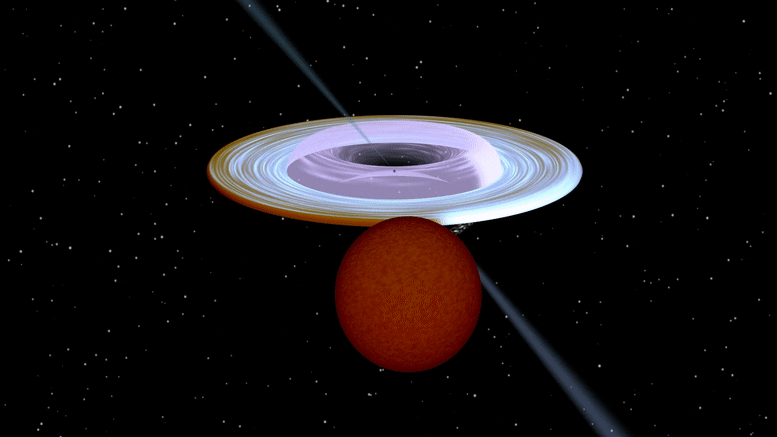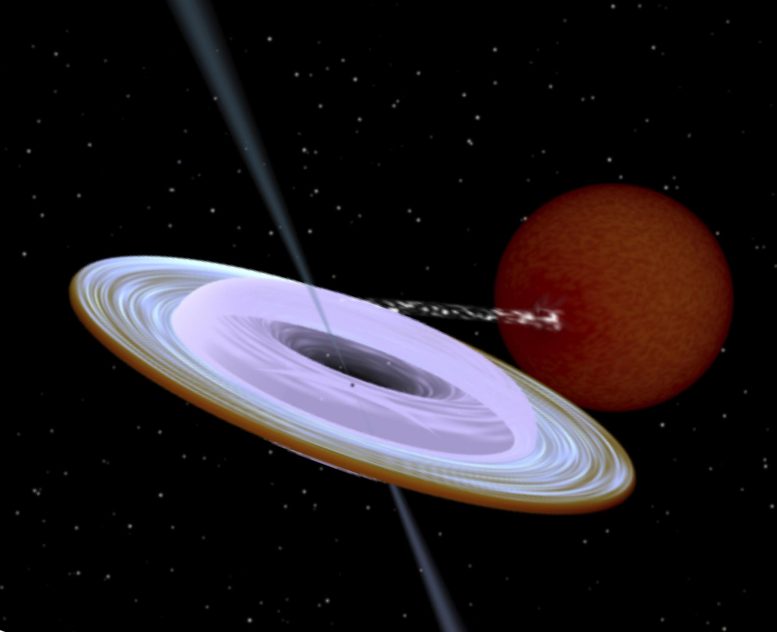
Researchers from the University of Turku, Finland, found that the axis of rotation of a black hole in a binary system is tilted more than 40 degrees relative to the axis of stellar orbit. The finding challenges current theoretical models of black hole formation.
The observation by the researchers from Tuorla Observatory in Finland is the first reliable measurement that shows a large difference between the axis of rotation of a black hole and the axis of a binary system orbit. The difference between the axes measured by the researchers in a binary star system called MAXI J1820+070 was more than 40 degrees.

Often for the space systems with smaller objects orbiting around the central massive body, the own rotation axis of this body is to a high degree aligned with the rotation axis of its satellites. This is true also for our solar system: the planets orbit around the Sun in a plane, which roughly coincides with the equatorial plane of the Sun. The inclination of the Sun rotation axis with respect to orbital axis of the Earth is only seven degrees.
“The expectation of alignment, to a large degree, does not hold for the bizarre objects such as black hole X-ray binaries. The black holes in these systems were formed as a result of a cosmic cataclysm – the collapse of a massive star. Now we see the black hole dragging matter from the nearby, lighter companion star orbiting around it. We see bright optical and X-ray radiation as the last sigh of the infalling material, and also radio emission from the relativistic jets expelled from the system,” says Juri Poutanen, Professor of Astronomy at the University of Turku and the lead author of the publication.
Artist impression of the X-ray binary system MAXI J1820+070 containing a black hole (small black dot at the center of the gaseous disk) and a companion star. A narrow jet is directed along the black hole spin axis, which is strongly misaligned from the rotation axis of the orbit. Image produced with Binsim. Credit: R. Hynes
By following these jets, the researchers were able to determine the direction of the axis of rotation of the black hole very accurately. As the amount of gas falling from the companion star to the black hole later began to decrease, the system dimmed, and much of the light in the system came from the companion star. In this way, the researchers were able to measure the orbit inclination using spectroscopic techniques, and it happened to nearly coincide with the inclination of the ejections.
“To determine the 3D orientation of the orbit, one additionally needs to know the position angle of the system on the sky, meaning how the system is turned with respect to the direction to the North on the sky. This was measured using polarimetric techniques,” says Juri Poutanen.
The results published in the Science magazine open interesting prospects towards studies of black hole formation and evolution of such systems, as such extreme misalignment is hard to get in many black hole formation and binary evolution scenarios.
“The difference of more than 40 degrees between the orbital axis and the black hole spin was completely unexpected. Scientists have often assumed this difference to be very small when they have modeled the behavior of matter in a curved time space around a black hole. The current models are already really complex, and now the new findings force us to add a new dimension to them,” Poutanen states.
Reference: “Black hole spin–orbit misalignment in the x-ray binary MAXI J1820+070” by Juri Poutanen, Alexandra Veledina, Andrei V. Berdyugin, Svetlana V. Berdyugina, Helen Jermak, Peter G. Jonker, Jari J. E. Kajava, Ilia A. Kosenkov, Vadim Kravtsov, Vilppu Piirola, Manisha Shrestha, Manuel A. Perez Torres and Sergey S. Tsygankov, 24 February 2022, Science.
DOI: 10.1126/science.abl4679
The key finding was made using the in-house built polarimetric instrument DIPol-UF mounted at the Nordic Optical Telescope, which is owned by the University of Turku jointly with the Aarhus University in Denmark.
Never miss a breakthrough: Join the SciTechDaily newsletter.
7 Comments
How can something like a black hole be tilted? In relationship to what?
In space, which way is UP? DOWN?
There are two axes of rotation.
One is that of the spin of the black hole itself. The other is the rotation of a nearby star around the black hole. The two axes are tilted with respect to each other.
Read the article. Understanding will be vouchsafed
yep
These illustrations doesn’t seem to show the extreme warp this puts in the accretion disk. From the paper:
“During the outbursts, such an extreme misalignment severely affects the accretion disk structure in the ultimate proximity of the black hole. For a non-zero spin, particles moving around the black hole in the orbits tilted, with respect to the black hole equatorial plane, undergo Lense-Thirring precession with the rate decreasing with radius. Hence, the tilted disk is subject to twist and warp. Evidence for a large misalignment challenges the models of quasi-periodic oscillations observed in black hole x-ray binaries, which rely on the solid-body Lense-Thirring precession of the inner parts of the accretion flow, as these imply the whole flow is misaligned by 2β from the orbital axis in some phases (3). For β ∼ 40◦ this means that the inner parts of the accretion disk would need to become almost perpendicular to its outer parts.
The black hole affects space in a spearical maner but the angle of the acreation disk shows the angle of the poles where powerfull X-rays are ejected, and it is much stronger than a simple star so it is spinning normaly while the stars orbit has a difrence of more than 40 degrees to the black holes equatorial plane
Is the 40degree rotation related to the 2 event horizons interacting making a sort of larger weaker version of an event horizons that surrounds the 2 black holes?